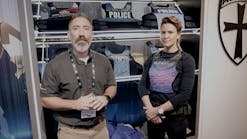In the station and in the media, everyone seems to be talking about body cameras, the wearable technology that is telling the true story about what is happening during emergency situations. In the past, it’s been a he-said-she-said while the community watches. But body cameras are not the only wearable technology hitting the market with the goal of making an officer’s job easier and safer. From accessories to body armor, these amped up uniforms are making officers safer, more comfortable and healthier.
Copper Ion Technology: Healthy and a curious, cool feeling
US Armor has been making officers safer since the 1960s. Recently, US Armor merged copper ion technology (CIT) with unique spacer fabric to create a comfortable, cooler and healthier vest. CuTec permanently binds copper to the textile on the body side of armor. This technology is similar to what has been used in athletics, such as knee and elbow braces. The NIJ.06 standard which required that ballistic panels be not just water-resistant but waterproof came with a cost: prickly heat rash and other heat/moisture-related skin disorders. “Many officers have sensitive skin,” explains Chad Keller, Marketing Director, US Armor. “Not only is (heat rash) extremely uncomfortable, officers cannot wear a vest while it is healing.” The CuTec copper ion technology doesn’t allow the development of heat rash and is also antimicrobial. “Bacteria doesn’t grow on copper well,” says Keller. CIT improves hygiene while at the same time reducing odors.
As if CIT wasn’t enough, US Armor also boasts a phase changing/heat-managing fabric, known as thermocules, which they use in their Outlast Outer Carrier. The second most common complaint from officers about vests is it’s too hot, explains Keller. Partnering with NASA, they addressed this concern with thermocules that absorb, store and release heat. “NASA used it in astronaut suits to regulate their body temperature in space,” Keller says. “When you’re stuck in your suit and cannot get out of it, you need heat management.” The same concept applies to officers. “This is one of the reasons why they don’t want to wear a vest,” explains Keller. US Armor took their product and tested it out in the field where officers praised the curious, cool feeling. “It regulates your temperature keeping the officer cool—no matter how long the shift is,” states Keller. “They could feel it immediately after putting it on.” Is this space-based technology affordable? Keller responds in the affirmative, explaining how US Armor’s goal is to incorporate the two worlds of affordability and comfort. “They never have to make the choice to either be comfortable or to be safe,” Keller says. He also boasts their products are made 100 percent in the U.S. “We’re proud of what we make and we’re the leader in officer comfort for both male and female.”
Body Armor: Lighter and thinner
Point Blank Enterprises, doing business since 1973, is the primary producer of body armor for the U.S. military. Utilizing their experience in this area, they improved their offerings to first responders on home ground. “What we are witnessing is that American law enforcement are facing more threats than ever,” explains Mike Foreman, Executive Vice President of International Business Development, Point Blank Enterprises. “Prior to 9/11, we would never have expected a terrorist attack on our soil. But now we think about officers being the first line of defense. Because of this, they require more safety than the last hundred years of law enforcement.” Foreman should know, he’s been in law enforcement for 42 years, including 17 years in SWAT.
Under Foreman’s tutelage and with a focus on giving officers the best protection available at the most affordable price, Point Blank forged a relationship with U.S. Special Forces to develop a lighter solution in body armor. The Alpha Elite Series is the first body armor ever made with the Dyneema Force Multiplier Technology by DSM. According to Point Blank, “this radically advanced polymer science combines with next-generation fiber technology and unique uni-directional engineering.” The Level II Alpha Elite meets NIJ.06 standards and is 20 percent lighter than the best competing models, weighing in at only 0.63 pounds per square foot (psf). The Level IIIA is 23 percent lighter weighing 0.87 psf. It’s also 31 percent thinner. Even with all this comfort, the Alpha Elite Series achieved a 5 percent increase in performance over their Vision Series. “We want it to be wearable without compromising the protection,” Foreman explains. “We want to produce a vest that officers will put on and wear the whole course of their duty. If they’re not wearing the vest they aren’t going to be safe.” Along with holding the contract with the U.S. Special Forces, Point Blank also provides vests to 50 percent of the U.S. law enforcement market, including more than 40 tactical SWAT teams, and the FBI.
Badges and other gadgets
Body armor is not the only wearable technology making things better for officers. A variety of accessories have hit the market as well, including 5.11 Tactical’s CFX badge. “It’s all about innovation,” says David Hein, Vice President, GMM, 5.11 Tactical. “You’re not using the same cellphone that you were using two years ago and certainly not ten years ago. You don’t see anyone carrying around a bag phone. Uniforms need to be upgraded and CFX is part of that solution.” CFX can be used in lieu of embroidery or a metal badge and can be applied to any textile on the market. It’s designed to outlast the textile it is applied to. “Once you put this one on, you really don’t know it’s there,” Hein says. “It’s permanent.” With seven different templates that can be laser-edged with the officer’s state seal, department and other identifying information, CFX upgrades the traditional patch. 5.11 also offers customizable badges, like the one they developed for the Bureau of Alcohol, Tobacco and Firearms (ATF). Like US Armor and Point Blank, 5.11 Tactical developed this product in collaboration, partnering with FiberLok Inc. two years ago. CFX looks like a metal badge. “It retains that authoritative look you get from a metal badge,” Hein explains. “It’s three dimensional. It’s comfortable. You don’t have to worry about something poking through.” You also don’t have to worry about the holes that traditional metal badges create in uniform material, especially special gear such as a waterproof jacket. “You don’t have to puncture the membrane and then go back and seal the hole,” states Hein. “We are not looking for this to replace a metal badge because that is an honor they receive. But when we look at a wearable solution this is one that hasn’t come along very often.”
Like US Armor’s technology, CFX started in the sporting arena. “The NFL jerseys in the Super Bowl and (NHL jerseys) in the Stanley Cup all have CFX. “The technology has been there, but we are the first to bring it to the public safety market,” says Hein. In the last year, hundreds of agencies have transitioned to CFX with dozens more switching each week. A big customer is the Department of Corrections, who historically could not wear a metal badge due to safety. “CFX gives them that authoritative look but it cannot be pulled off or used as a weapon,” explains Hein. “You’d have to rip a hole in the shirt or jacket to get it off. Then it wouldn’t be very dangerous as it’s just a flexible object.”
If a body says so
Another wearable technology designed to keep officers safe merges communications with body analytics to increase situational awareness. Although in 2013 Motorola hadn’t planned on marketing its Google Glass solution, a partnership changed that as innovators asked if there was an appropriate use in public safety. Tom Gutherie, Vice President of Smart Public Safety Solutions, Motorola says there is ... and this response became the catalyst for Motorola’s relationship with Recon Instruments, an award-winning technology company behind the world’s leading consumer Heads-Up Displays (HUD) for sports. Recon makes rugged Google Glass-type smartglasses.
Incorporating the smartglasses with their APX 7000XE Portable Radio or LEX L10 Android-based ruggedized phone, Motorola’s system allows voice, text or data to be delivered to and from the officer. Along with the smartglasses, Motorola is also developing a smart belt which transmits body analytical information from the officer back to the command center.
“It’s an officer’s tool belt equipped with sensors that can show that a gun, handcuffs or Taser has been pulled,” explains Anatoly Delm, Director of Global Infrastructure Marketing, Motorola. Transmitted securely via Bluetooth, the information can be put into a situational context. “The mere fact that the gun has been withdrawn from his holster may not be important,” explains Delm. “You’re not sure it’s relevant. Maybe he took it out because he’s cleaning it.” Paired with the bio-sensors, the information takes on a different tone. “You know that officer was running,” Delm says. “Her heart rate is elevated and her weapon has been withdrawn. That is important.” If the officer is also wearing the smartglasses, sensors can trigger the camera to start transmitting what the officer is seeing. “Now the officer can communicate her situation or her stress even though she is fully focused on the situation at hand. She is not required to talk or push buttons or do anything at all. The technology is able to figure out that the officer is in a situation that she needs help, and possibly is in danger.”
The future
Even with these exciting products entering the market, each of these companies is still looking at how they can continue to collaborate and develop new solutions to law enforcement problems. US Armor has a Level II vest coming out in their 6000 series. “It’s the latest, thinnest and most lightweight,” says Keller. “We also have a combination ballistic and stab vest with a blade plate in a Level II coming out in 2015 as well.”
Point Blank is also looking towards innovation. “We’re seeing more saves where officers are shot,” says Foreman. “We are working on the next generation of lightweight armor. We hope in early 2016, American law enforcement will see another breakthrough.”
5.11 Tactical has a CFX badge for an officer’s wallet in the works, as well as the ability to put an RFID chip in the badge. This would be useful, especially in other countries where identifying the officer as authentic is hugely important.
Even though body cameras seem to be the only wearable technology that’s talked about in mainstream media, companies who are focused on officer safety continue to improve and upgrade other wearable technology. More and more products are being developed with a focus on affordability, comfort and protection. “The stakes on this are just so high,” concludes Delm. “We know we must always get it right because at the end of the day, it’s the difference between an officer being safe in their job or not.”

Michelle Perin
Michelle Perin has been a freelance writer since 2000. In December 2010, she earned her Master’s degree in Criminology and Criminal Justice from Indiana State University.



